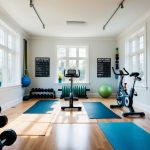
The Role of Yoga in Enhancing Flexibility
Yoga places a strong emphasis on flexibility through its varied postures and poses. Incorporating deep stretches, yoga facilitates an increased range of motion in the joints and muscles. Poses like the “Downward Dog” or “Forward Bend” are instrumental in loosening tight muscles and relieving tension.
By participating in yoga sessions, individuals can expect not just improved flexibility but also enhanced stability and balance. Yoga’s holistic approach engages both the mind and body, promoting relaxation while physically challenging the practitioner. This makes yoga a valuable component of a fitness plan aimed at increasing flexibility and supporting core strength.
Strength Training Without the Strain
Strength training doesn’t have to involve heavy weights or high-intensity workouts. Simple tools like resistance bands and bodyweight exercises can build strength effectively while minimizing joint strain.
Utilizing Resistance Bands
Resistance bands offer a versatile way to enhance muscular strength without the need for heavy machinery. These bands can be used in various ways to target muscle groups across the body. For lower body strength, exercises like squats and lunges become more challenging when performed with bands. By adjusting the tension, one can easily modify the intensity of the workout to suit different fitness levels.
Apart from working the lower body, resistance bands are great for engaging the upper body. Moves like bicep curls and tricep extensions benefit from the stability and control afforded by the bands. One key advantage is portability, making them an excellent choice for home workouts or travel. They provide a safe way to add resistance without overburdening the joints.
Bodyweight Exercises for Every Level
Bodyweight exercises rely solely on the individual’s weight to provide resistance, making them a convenient option for strength training. Modifications allow these exercises to be suitable for beginners and advanced fitness enthusiasts alike. Classic exercises like push-ups, planks, and squats effectively target multiple muscle groups, including lower body strength areas.
Incorporating variations can help meet different fitness goals and keep routines fresh. An exercise such as a single-leg squat challenges balance and strength, offering a more difficult progression for those seeking a greater challenge. For individuals new to fitness, starting with assisted versions or reduced repetitions can help build a foundation safely.
By adjusting the difficulty and variety of exercises, practicing without additional weights becomes accessible and effective, accommodating anyone’s journey to improved strength.
Incorporating High-Intensity Low-Impact Training (HILIT)
High-Intensity Low-Impact Training (HILIT) combines the cardiovascular benefits of high-intensity workouts with joint-friendly movements, making it suitable for all fitness levels. It involves adapting traditional high-intensity interval training (HIIT) into a low-impact format and employing circuit training techniques to maintain effectiveness while reducing strain.
Modifying HIIT for Low-Impact
Traditional HIIT workouts often include exercises like jumping jacks or burpees, which can strain the joints. To modify these for low-impact, exercises such as step jacks, modified burpees, or low-step lunges can be used. These alternatives provide high-intensity benefits while minimizing joint stress.
Modifications should focus on maintaining intensity through increased repetition or speed rather than impact. Trainers emphasize the importance of maintaining proper form to prevent injury and ensure efficacy. Strengthening core muscles can help maintain balance and reduce the need for high-impact movements. Including rest intervals is crucial to give the body time to recover and maintain performance throughout the session.
Circuit Training Techniques
Circuit training in a HILIT format is an effective way to build strength and endurance while keeping things low-impact. This involves performing a series of exercises targeting different muscle groups with minimal rest in between. Exercises like bodyweight squats, push-ups on the knees, and seated row variations can be effective components.
Varied circuit routines can keep these sessions engaging while ensuring a comprehensive full-body workout. Equipment like resistance bands and light weights can add intensity without increasing joint stress, providing resistance that enhances muscle engagement. Transitioning smoothly between exercises helps maintain heart rate levels, contributing to cardiovascular benefits similar to traditional HIIT.



